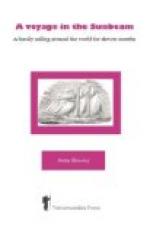[Illustration: Pin for fastening Cloak, made from a Dollar, beaten out.]
The Fuegians, or Canoe Indians, as they are generally called, from their living so much on the water, and having no settled habitations on shore, are a much smaller race of savages, inhabiting Tierra del Fuego—literally Land of Fire—so called from the custom the inhabitants have of lighting fires on prominent points as signals of assembly. The English residents here invariably call it Fireland—a name I had never heard before, and which rather puzzled me at first. Whenever it is observed that a ship is in distress, or that shipwrecked mariners have been cast ashore, the signal-fires appear as if by magic, and the natives flock together like vultures round a carcase. On the other hand, if all goes well, vessels often pass through the Straits without seeing a single human being, the savages and their canoes lying concealed beneath the overhanging branches of trees on the shore. They are cannibals, and are placed by Darwin in the lowest scale of humanity. An old author describes them as ’magpies in chatter, baboons in countenance, and imps in treachery.’ Those frequenting the eastern end of the Straits wear—if they wear anything at all—a deerskin mantle, descending to the waist: those at the western end wear cloaks made from the skin of the sea-otter. But most of them are quite naked. Their food is of the most meagre description, and consists mainly of shell-fish, sea-eggs, for which the women dive with much dexterity, and fish, which they train their dogs to assist them in catching. These dogs are sent into the water at the entrance to a narrow creek or small bay, and they then bark and flounder about and drive the fish before them into shallow water, where they are caught.
[Illustration: Fuegian Boat and Oars.]
Bishop Stirling, of the Falkland Islands, has been cruising about these parts in a small schooner, and visiting the natives, for the last twelve years, and the Governor here tells us that he has done much good in promoting their civilisation; while the hardships he has endured, and the difficulties and dangers he has surmounted, have required almost superhuman energy and fortitude on his part. The Fuegians, as far as is known, have no religion of their own.




